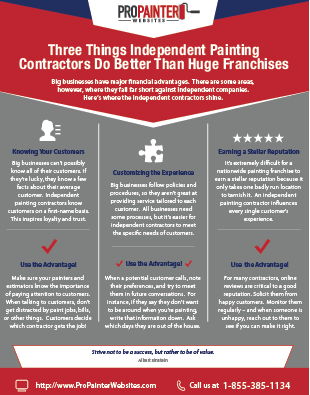Comprehending Seasonal Influences On Commercial Outside Paint: Necessary Expertise For Success
Comprehending Seasonal Influences On Commercial Outside Paint: Necessary Expertise For Success
Blog Article
Highly recommended Internet page -Aguilar Rodriquez
When you're planning a business exterior painting project, seasonal variables can make or break your outcomes. visit the next website 'll wish to take into consideration how temperature level and humidity influence paint application and drying times. Choosing the right period can ensure your paint adheres correctly and lasts much longer. However which seasons are truly the most effective for this sort of work? Let's explore the key elements that can influence your task's success.
The Effect of Temperature on Paint Application
When you're preparing a commercial outside paint job, the temperature level can dramatically influence exactly how well the paint adheres and dries.
Ideally, you intend to paint when temperatures vary between 50 ° F and 85 ° F. If it's as well cool, the paint may not treat effectively, resulting in concerns like peeling off or breaking.
On the other side, if it's also warm, the paint can dry out too quickly, preventing correct bond and causing an unequal coating.
You must additionally think about the moment of day; morning or late afternoon offers cooler temperature levels, which can be much more positive.
Always check the manufacturer's referrals for the specific paint you're using, as they frequently give guidance on the optimal temperature range for optimal outcomes.
Humidity and Its Result on Drying Times
Temperature level isn't the only environmental factor that affects your business external painting task; moisture plays a considerable function too. High moisture degrees can decrease drying times significantly, impacting the overall high quality of your paint task.
When the air is saturated with wetness, the paint takes longer to heal, which can lead to issues like bad bond and a higher risk of mold growth. If you're painting on a particularly moist day, be prepared for extensive delay times between coats.
It's vital to check neighborhood weather conditions and plan appropriately. Ideally, go for humidity levels between 40% and 70% for optimal drying out.
Maintaining these consider mind ensures your task stays on track and supplies an enduring coating.
Best Seasons for Commercial Exterior Painting Projects
What's the best time of year for your commercial exterior paint projects?
Spring and early loss are normally your best bets. Throughout these seasons, temperatures are moderate, and moisture levels are often lower, producing excellent problems for paint application and drying.
Stay clear of summertime's intense heat, which can create paint to completely dry also quickly, resulting in bad bond and surface. In a similar way, wintertime's cool temperature levels can prevent appropriate drying out and healing, risking the durability of your paint task.
Aim for days with temperature levels in between 50 ° F and 85 ° F for optimal outcomes. Keep in mind to check the local weather prediction for rain, as wet conditions can ruin your project.
Planning around these factors ensures your paint job runs smoothly and lasts longer.
Final thought
To conclude, preparing your business outside painting projects around seasonal factors to consider can make a substantial difference in the outcome. By scheduling job during the perfect temperatures and humidity levels, you'll ensure much better bond and drying out times. Remember to keep indianapolis commercial painting on regional weather report and pick the correct time of year-- spring and very early fall are your best bets. Taking these actions will aid you attain a durable and expert coating that lasts.
